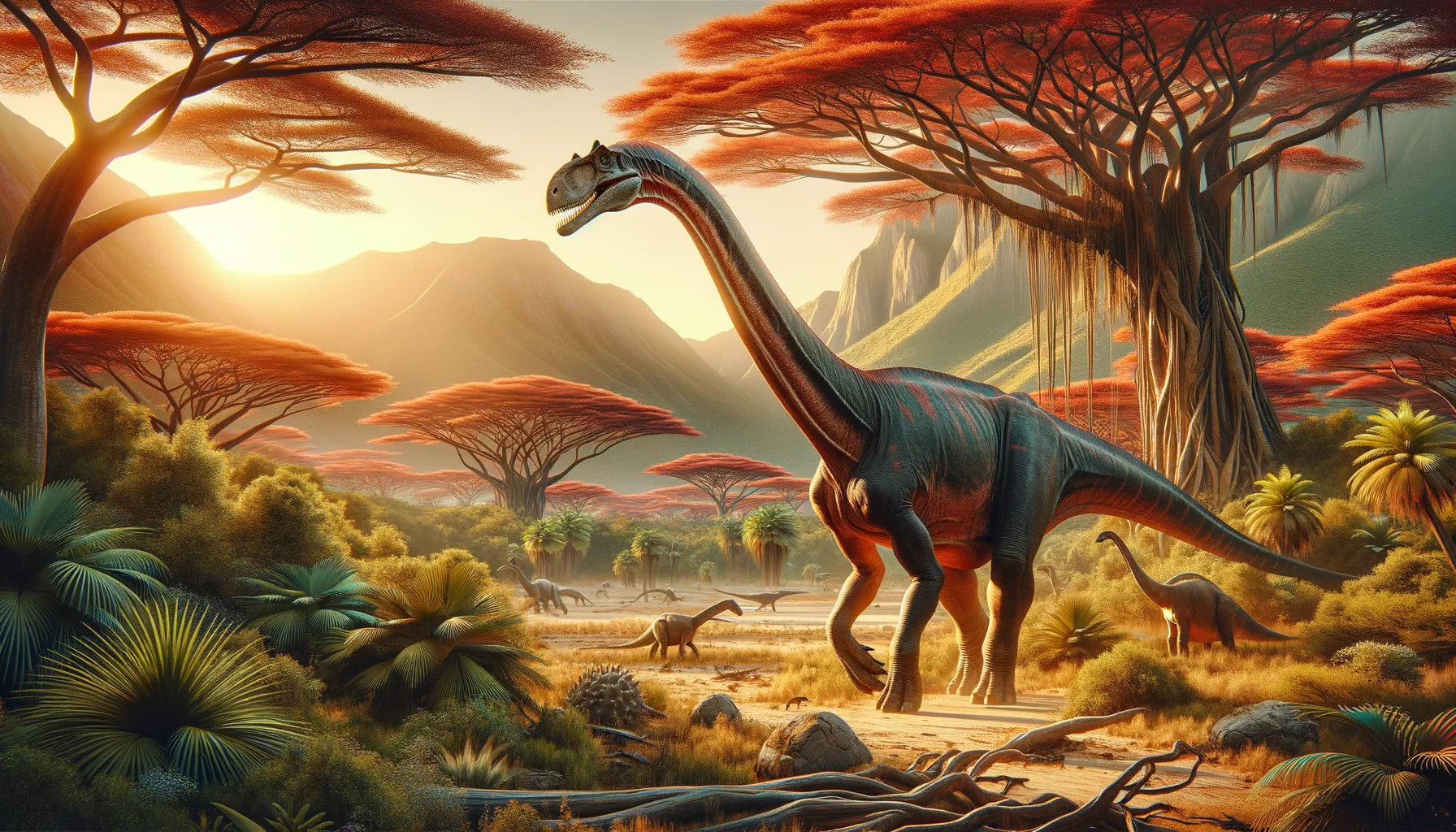
Wamweracaudia
Majestic giant of the prehistoric plains.
Period
Jurassic
Length
Approximately 15 to 20 meters long.
Height
Stood about 3 to 4 meters tall at the shoulder.
Weight
Estimated at several tons, like other sauropods.
Wamweracaudia is a long-necked, tail-brushing sauropod dinosaur known for its impressive size and herbivorous diet. It roamed the Earth during the Late Jurassic period, feeding on abundant plant life. Discovered in Tanzania, Wamweracaudia contributed greatly to our understanding of dinosaur evolution in Africa. This gentle giant showcases the diversity of sauropods that thrived millions of years ago.
Diet
Wamweracaudia was a herbivore, relying on a diet of leaves, ferns, and other plant material. Its long neck allowed it to reach vegetation high in trees as well as ground plants, giving it a diverse nutritional intake.
Hunting
Being a herbivore, Wamweracaudia did not hunt. It foraged through ancient forests in search of its plant-based diet. Its massive size likely deterred predators, allowing it to graze peacefully.
Environmental challenges
Wamweracaudia faced challenges such as fluctuating climates, which influenced the availability of its food sources. Shifts in plant types and distributions meant it needed to adapt to seasonal availability of different plants. Additionally, geological events could alter the landscape, affecting its habitat and movement patterns. Predation remained a risk, especially to the young or sick individuals.
Speed
Slow-moving, typical of large herbivores.
Lifespan
Likely several decades, similar to modern large animals.
First discovery
Discovered in Tanzania, 2014 by paleontologist Dr. Patrick O'Connor.
Fun Facts
- Wamweracaudia is a dinosaur that lived about 160 million years ago during the Late Jurassic period.
- Its name means 'tail from Wamwera,' which highlights its unique fossil found in the Wamweri region of Tanzania.
- Wamweracaudia was a sauropod, known for its long neck and tail, making it akin to the gentle giants of the dinosaur world.
- The discovery of Wamweracaudia has provided valuable insights into the diversity of sauropods in the ancient ecosystems of Africa.
- Unlike its more famous sauropod relatives like Brachiosaurus, Wamweracaudia is known from relatively fewer fossil remains.
- Despite its size, like other sauropods, it's believed that Wamweracaudia was a plant-eater, feasting on ancient ferns and conifers.
- Wamweracaudia's fossils help scientists understand the evolution and distribution of sauropods across different continents.
Growth and Development
Wamweracaudia showed typical sauropod growth, starting from eggs and rapidly increasing in size. Young sauropods were likely more agile, helping them avoid predators until they reached a size that offered more protection. Social structures may have played a role in the protection and nurturing of young ones. As it matured, Wamweracaudia's growth slowed but continued steadily throughout its life.
Habitat
Wamweracaudia inhabited lush river valleys with abundant vegetation in what is now Tanzania. The presence of rivers and lakes supported diverse plant life, crucial for its diet. It adapted to both forested areas and open plains, moving between regions to access its required vegetation. The Late Jurassic environment was dynamic, with seasons affecting plant growth and distribution.
Interaction with other species
Wamweracaudia likely coexisted with other herbivorous dinosaurs, forming mixed species herds for better protection. Its large size and long tail served as deterrence against apex predators of its time. This giant sauropod would have had interactions with smaller dinosaur species, which may have fed on similar vegetation but at different heights. Mutual cooperation or competition for resources determined interspecies dynamics.
Natural lifespan
Wamweracaudia likely lived for 70 to 100 years in the wild.
Reproduction
Like many dinosaurs, Wamweracaudia reproduced by laying eggs. The eggs were likely laid in nests, possibly communal nesting grounds to increase the survival odds of the offspring. Hatchlings would have been relatively small, requiring some protection and nurturing. Parental care may not have extended far beyond laying eggs, with juveniles relying on herd protection as they grew.
Social behaviour
Wamweracaudia might have lived in herds, which offered safety in numbers against predators. These herds could be composed of different age groups, providing social structures that benefited younger and weaker members. Herding behaviors also could help manage resources efficiently across the group. Communication would be necessary to coordinate movement and alert others to potential threats.
Fossil locations
Fossils of Wamweracaudia have primarily been found in the Middle Dinosaur Beds of Tendaguru, Tanzania. These sites are rich in dinosaur remains and offer insights into the diverse prehistoric ecosystem of East Africa during the Late Jurassic period. The fossil discoveries provide crucial evidence for paleontologists studying dinosaur distribution and evolution on the African continent.
